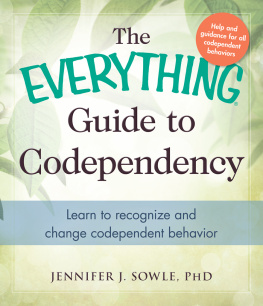Summary
Codependent No More:
How to Stop Controlling Others and Start Caring for Yourself
By Summary Station
Copyright 2016 by Summary Station
All rights reserved. This book or any portionthereof
may not be reproduced or used in any mannerwhatsoever
without the express written permission of thepublisher
except for the use of brief quotations in a bookreview.
Printed in the United States of America
First Printing, 2016
Smashwords Edition
Table ofContents
About MelodyBeattie:
Melody Beattie: The author is a recoveringdrug and alcohol user. After finding herself in a relationship withan alcoholic, Melody Beattie began to struggle with codependency.Because she recognized codependency as a challenge many face, shewrote Codependent No More after she was divorced in order tohelp others like her.
KEYTAKEAWAYS
l. Codependency is a very complicatedissue; however, understanding this issues intricacies is key tohealing.
2. Codependents tend to be reactionary,but if they learn how to act properly and understand their needs,then they can make good, healthy decisions. Reacting withoutthinking is self-destructive behavior.
3. Codependents detach from themselveswhen they become too attached to another person. To truly heal fromcodependency, a person needs to detach from their obsession withthe addict and his or her behavior to realize that healing comesfrom within.
4. Codependents are by naturecontrolling, but by trying to control others, they are actuallycontrolled. Thus, to heal, codependents have to learn how to becomeundependent.
5. Codependents are drawn to addicts andbecome their caretakers, rescuers, and enablers. This kind ofbehavior leads to the Drama Triangle, where the codependent willrescue the person, persecute the person rescued, and then feel likea victim.
6. Being so involved with other peoplesbusiness can make Codependents feel crazy. Codependents mustrecognize that they are responsible for taking care of themselves,not for taking care of the addict.
7. Codependents must learn to care fortheir emotional selves by allowing their feelings to come out. Whenfeelings are ignored, it becomes detrimental to the codependentperson.
8. Codependents must acknowledge thatthere is a higher power, or God, who wants to help them.
9. There are Twelve Step programs thatare a wonderful resource for codependents.
10.Once a codependent becomesundependent, it is important for that person to learn to live andlove again.
Key Takeaway 1
Codependency is a very complicated issue; however,understanding this issues intricacies is key to healing.
Analysis
Although the essential characteristics ofcodependency are similar, treating codependency and itsmanifestations tend to be very complex. It is complex because eachpersons experiences with codependency are uniquely shaped by whatthey experience. In other words, because no two people are exactlyalike, no two people will act the same way. What a personexperiences growing up as well as his or her personality traits canand will affect how that person sees the world and how he or shereacts to it.
Thus, people react in a very individual way,which is determined by many factors. For example, an adult will beshaped by the rules he or she was raised with as a child. If aparent teaches a child to repress their emotions, that may be oneof the challenges they face as an adult codependent. Likewise,people with passive versus aggressive personalities will react verydifferently to situations. A persons passivity will shape his orher codependency. In addition, someone in a relationship with analcoholic will undoubtedly experience codependency differently thana person who is in a relationship with an gambler. So two aspectscome to determine a persons codependency: the individualsexperiences as well as the person with whom they are in arelationship.
One must understand the intricacy ofcodependency before beginning the process of trying to heal fromcodependency. The reason for this is because everyone experiencescodependency in a very different way, so each persons healingjourney is also very unique. In other words, for a person to findthe right solution, he or she must define and understand theproblem first. Conversely, when codependents fail to address thespecifics of their own conditions, they will have difficultyhealing properly. It is important to note, then, that eachcodependents journey to healing depends on them focusing onthemselves.
Key Takeaway 2
Codependents tend to be reactionary, but if theylearn how to act properly and understand their needs, then they canmake good, healthy decisions. Reacting without thinking isself-destructive behavior.
Analysis
A major characteristic of codependents isthat they are very reactionary. Its not that the reaction initself is wrong because reacting to ones environment and stimuliis normal. All people do this on a daily basis. However, when thecodependent feels like they are constantly trying to manage acrisis and are unable to get their bearings, they respond byoverreacting.
Codependents reactthey rarely act. To actrequires a person to have foresight, and codependents are soreactionary, they do not have that foresight because they areusually responding. This persistent state of reaction over actionwill turn into additional anxiety and loss of confidence. When thishappens, a vicious cycle occurs where a codependent doesnt havethe confidence to act. Then, he or she overreacts to a situation,realizes they behaved inappropriately, feels guilt for this, andthen loses more confidence. It is a triggered reaction and cyclefor the codependent. Unfortunately, as a codependent personcontinues acting this way, it becomes a habit, which is verydifficult to break. Therefore, codependency is called a diseasebecause this self-destructive behavior becomes habitual and must betreated in the same way other diseases are treated.
Luckily, there are ways to address thisreactive behavior. Once this tendency to react is acknowledged, acodependent person can change their behavior by learning how torecognize what brings about or triggers a reaction. So awareness isthe first step. Then, that person can pause, evaluate thesituation, and figure out the best way to act. This is like theidea of taking a moment and collecting your thoughts. When peopledo this, they take time to think about what is happening and thebest way to handle it. The conscious effort allows a person time tounderstand what is causing the reaction. Thus, the idea withreacting is similar. The person needs to think about what wouldbenefit them most and then act. Just taking time out to think aboutwhy one reacts, breaks the chain of overreaction, and when thishappens, ones confidence and peace will return. Most of all, whencodependents act instead of react, they will learn that they cantrust their thoughts and make good, healthy decisions.
Key Takeaway 3
Codependents detach from themselves when theybecome too attached to another person. To truly heal fromcodependency, a person needs to detach from their obsession withthe addict and his or her behavior and realize that healing comesfrom within.
Analysis
Attachment is not inherently negative.Healthy attachment is part of everyones lives. However, whenattachment is taken to extreme levels, it can become very damaging.Codependent people face this type of unhealthy attachment. Whenthey are in a destructive relationship, they become so wrapped upin the addict and his or her issues, the codependent cannot figureout a solution. They become blinded by the addicts behavior andcannot see or think clearly. This obsession can manifest in severalways, but the result for the codependent is that when they becomehyper-focused on the addict, they lose touch with themselves. Itbecomes an obsession. Furthermore, this obsession often forces thecodependent person to compulsive action in an attempt to try tofight a threat they imagine to be there. Though they may not knowor realize what the threat is, they perceive it to be there. Thiscompulsion is not helpful nor is it rational.


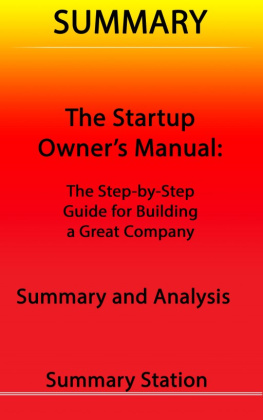

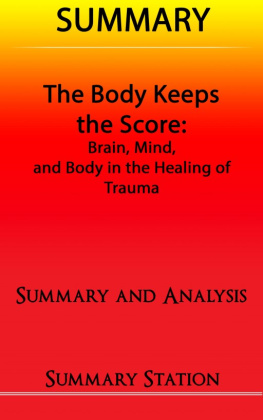

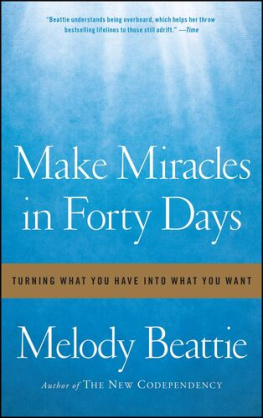

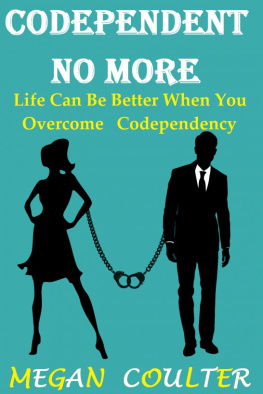

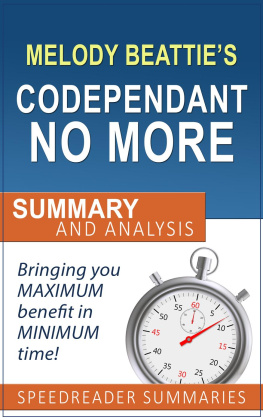

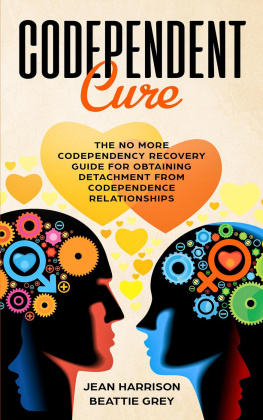

![Beattie - Melody Beattie bundle: [a collection of four Melody Beattie best sellers]](/uploads/posts/book/249274/thumbs/beattie-melody-beattie-bundle-a-collection-of.jpg)
